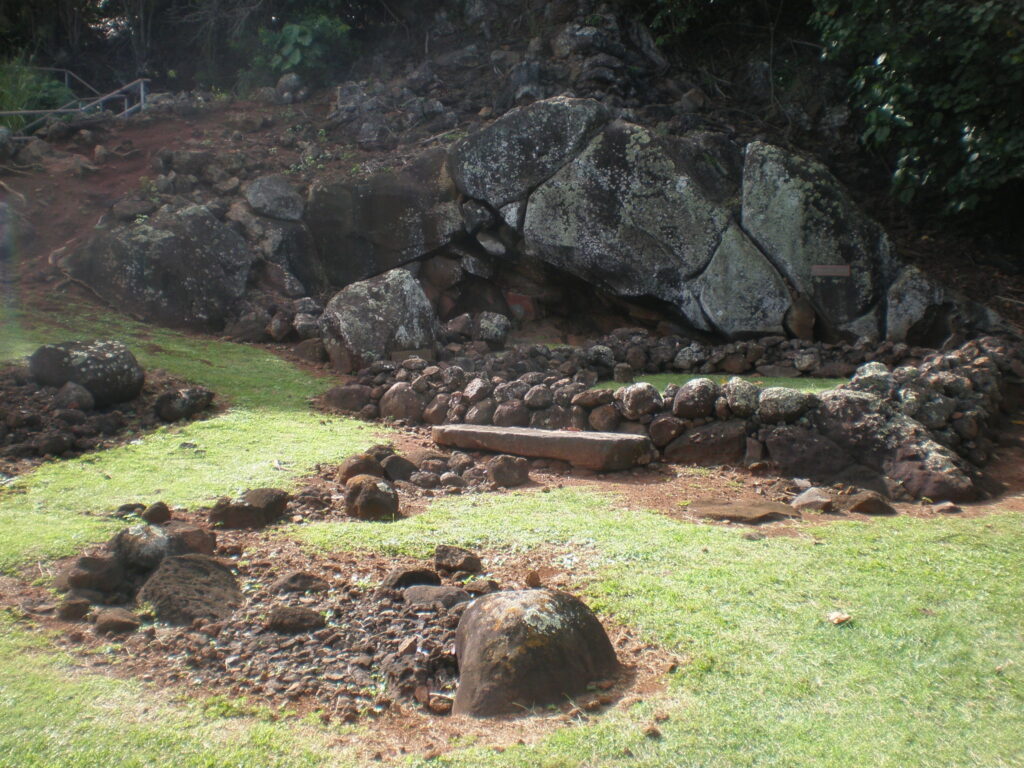Kalola, the highest tabu chiefess of the Maui court, was a daughter of Queen Kekuʻiapoiwa I (a daughter of Keawe of Hawaiʻi) and King Kekaulike of Maui.
She was thus a granddaughter of Kalanikauleleiaiwi, Queen of Hawaiʻi and sister of the King Kahekili II. She was an aunt of the King Kalanikūpule.
When Kekaulike died, Kalola’s brothers Kamehamehanui (an uncle of Kamehameha I) and Kauhi fought each other for rule of Maui in 1738. Battles were fought across West Maui; the war ended with the battle Koko O Nā Moku (“Bloodshed of the Islands;” Kamehamehanui won.
Kalola lived with two brothers, Kalaniʻōpuʻu and Keōua, both Hawai’i island niʻaupiʻo (very high rank) chiefs. From Kalaniʻōpuʻu, the older brother, she had a son, Kalanikauikeaouli Kiwalaʻo (Kiwalaʻo.) From Keōua, the younger brother, she had a daughter, Kekuʻiapoiwa Liliha.
The children, Kiwalaʻo and Kekuʻiapoiwa, had the same mother, different fathers, offspring of a naha union (brother-sister mating of niʻaupiʻo chiefs.) These two lived together, and Keōpūolani was born to them, also the offspring of a naha union. (Mookini)
Keōpūolani (granddaughter of Kalola,) who was raised in Wailuku, Olowalu and Hāmākua on Maui, was later queen of Kamehameha I (we’ll get more into that a little bit later.)
At the time of Captain Cook’s arrival (1778-1779), the Hawaiian Islands were divided into four kingdoms: (1) the island of Hawaiʻi under the rule of Kalaniʻōpuʻu, who also had possession of the Hāna district of east Maui; (2) Maui (except the Hāna district,) Molokai, Lānai and Kahoʻolawe, ruled by Kahekili; (3) Oʻahu, under the rule of Kahahana; and (4) Kauai and Niʻihau, Kamakahelei was ruler.
In 1782, following the death of Kalaniʻōpuʻu, Kiwalaʻo was briefly ruler of the island of Hawaiʻi. That year, his cousin, Kamehameha I, challenged his authority at the battle of Mokuʻōhai. Kīwalaʻō was killed in combat by Keʻeaumoku, one of Kamehameha’s officers. The victory at the battle of Mokuʻōhai was the start of Kamehameha’s rise to power
After the deaths of Kalaniʻōpuʻu and Kiwalaʻo, Kalola left for Maui, taking with her Keōpūolani. Kahekili, brother of Kalola, provided for the family and gave them his protection. After the conquest of Oahu by Kahekili he removed his court to that island, taking with him his sister and her family.
In 1785, they returned to Maui with Kalanikūpule, the son of Kahekili, who had been appointed chief of the island, and there remained, principally at Olowalu, until 1790. (Kalākaua)
At about that time, Simon Metcalf (captaining the Eleanora) and his son Thomas Metcalf (captaining the Fair American) were traders; their plan was to meet and spend winter in the Hawaiian Islands.
The Eleanora arrived in the islands first at Kohala on the island of Hawaiʻi. After a confrontation with a local chief, Simon Metcalf then sailed to the neighboring island of Maui to trade along the coast.
Kalola ruled the puʻuhonua of Olowalu and presided over Kaʻiwaloa Heiau. Kahekili, ruler of Maui, lived at Halekiʻi Heiau in Wailuku. This indicates the important spiritual, political and economic connection between ʻIao and Olowalu. Kalola was still ruling at Olowalu in 1790 when Simon Metcalf fired cannons on Honua’ula and Olowalu during the Olowalu Massacre.
Several months after the massacre at Olowalu, Kalola watched the great Battle of Kepaniwai from a panoramic flat area in the back of ʻIao Valley. Kamehameha stormed Maui with over twenty thousand men, and after several battles Maui troops retreated to ʻIao Valley.
Maui Island was conquered and its fighting force was destroyed – Kalanikūpule (Kahekili’s eldest son and heir-apparent) and some others (including Kalola and her family) escaped over the mountain at the back of the valley and made their way to Molokai and Oʻahu.
“The fugitives fled across the sharp ridges of the mountains, the mother carrying the child on her back and the kahu carrying mother and child, until they were able to escape to Molokai.” (Kamakau)
On the island of Molokai at Kalamaʻula, Kalola became ill and they could not carry out their original intention of going to Oʻahu to join Kahekili. Kamehameha followed Kalola to Molokai and asked Kalola for Keōpūolani (Kalola’s granddaughter) to be his queen.
Kalola, who was dying, agreed to give Kamehameha Keōpūolani and her mother Kekuʻiapoiwa Liliha, if he would allow the girls to stay at her death bed until she passed. Kamehameha camped on Molokai until Kalola died, and returned to Kona with his high queen Keōpūolani.
At Kalola’s death, “They wailed and chanted dirges, and some were put to sleep with the dead, and the chiefs tattooed themselves and knocked out their teeth. Kamehameha was also tattooed and had his eyeteeth knocked out, and the chiefs and commoners acted like madmen.” (Kamakau)
Kamehameha then formally took charge of and returned to Hawaiʻi with her daughter and granddaughter, not only as a sacred legacy from Kalola, but as a token of reconciliation and alliance between himself and the elder branch of the Keawe dynasty. (Kalākaua)
Later, Liholiho (Kamehameha II,) Kauikeaouli (Kamehameha III) and Princess Nahiʻenaʻena were born to Kamehameha and Keōpūolani.










































